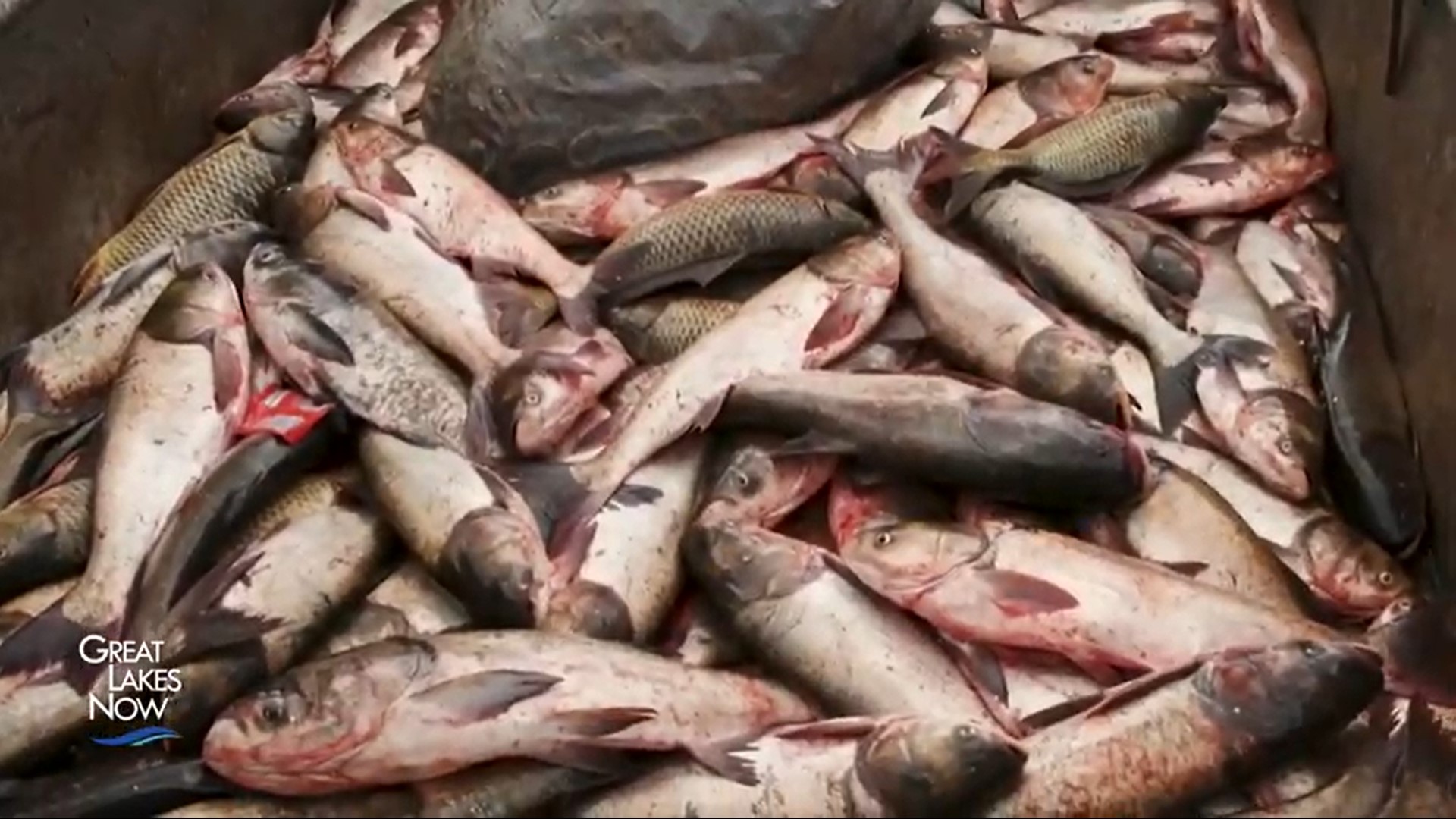
Science Says What? is a monthly column written by Great Lakes now contributor Sharon Oosthoek exploring what science can tell us about what’s happening beneath and above the waves of our beloved Great Lakes and their watershed.
Thirteen years ago, a live bighead carp was caught within swimming distance of Lake Michigan. It had somehow slipped past an electric barrier in the Chicago Area Waterway System designed to keep out the invasive fish.
While it caused a lot of justifiable hand wringing, I always suspected a small group of University of Notre Dame researchers was at least a little bit relieved.
Not because they wanted the voracious fish to upend the lake’s ecosystem. But because it was proof all the effort they’d put into a new detection tool – eDNA – was worth it.
If the invasive carp enter the Great Lakes, they might very well gobble up everything, leaving nothing for native fish to eat. So after water samples behind the barrier came back positive for bighead carp eDNA, the researchers had raised the alarm.
At the time, there was some question about whether they were crying wolf.
“In the early days, there was a lot of skepticism around eDNA”, says Kara Andres, an aquatic ecologist with Washington State University in St. Louis. Was it really sensitive enough to be a reliable signal of a species’ presence?
The carp’s capture meant it was indeed sensitive enough. It also meant that eDNA was more likely than netting to detect the fish when there aren’t a lot of them.
But now that scientists have had more time to work with eDNA, they have shown it can be a more important tool for conservation science than anyone suspected 13 years ago.
eDNA is short for environmental DNA. All creatures – including us – are constantly shedding bits of our genetic code in the form of hair, skin, mucus, feces, urine, etc. In the case of fish, eDNA can be collected from water samples and used to identify them.
There are still limits to what it can do. We can’t know if eDNA was dropped by a fish-eating bird or arrived via boat bilge water. And eDNA can’t tell us whether there’s a self-sustaining population in Lake Michigan, although the best guess is that it’s unlikely.
It can’t even tell us if the fish is alive or dead.
Widening the eDNA net
Andres, who completed her PhD with David Lodge, an invasive species expert and one of those early eDNA researchers, says despite these limits, conservationists are finding it more and more useful.
For example, the largest eDNA monitoring project in Canada – launched near Lake Huron in 2021— is designed to track the long-term effects on wildlife of containing spent fuel from the country’s nuclear power plants deep in the bedrock.
Canada’s Nuclear Waste Management Organization is considering the lakeside community of South Bruce for underground burial of spent nuclear fuel. The University of Guelph researchers leading the project will use eDNA to measure species diversity and abundance before and after used nuclear fuel bundles are stored.
They also hope to better understand how aquatic and semi-aquatic creatures change where they congregate according to the seasons, and to pick up signals from species that more traditional techniques often miss.
Freshwater mussels, for example, can be hard to find and identify by sight – some species don’t look much different from others. But eDNA can tell them apart.
A little high school science
eDNA work is evolving in other important ways. This summer, Andres co-published research showing it can signal not only the presence of a species, but genetic variation within a particular group.
This opens new possibilities for protecting endangered and vulnerable wildlife populations and for managing destructive invasive creatures.
If you remember your high school science, you’ll recall that in the cells of most animals, the nucleus contains two copies of the full genetic code.
But cells can contain hundreds more copies of a smaller, stripped-down version of the genetic code in mitochondria. Mitochondria are organelles inside cells responsible for generating the energy we need to live.
Most research on eDNA focuses on mitochondrial DNA because there’s so much more of it, making it easier to detect. While mitochondrial eDNA is good for distinguishing between species, the nuclear genetic code can provide a lot more information about variation within species.
But until Andres’s study, it was not clear if nuclear DNA could be assessed with eDNA techniques.
Round goby study
Andres and her team figured out it could be done by taking tissue samples from round goby fish and eDNA samples of water the fish inhabited. They found that the two methods provided comparable genetic information when focusing on nuclear DNA.
That’s important because the more detailed information available in nuclear eDNA could potentially let us trace the source of a new invasive population, such as the round gobies Andres worked with.
Round gobies, which arrived in the Great Lakes from Europe and Asia in the early 1990s via ship ballast, have been here long enough to evolve a slightly different genetic code than round gobies swimming in European and Asian lakes.
Mitochondrial eDNA can alert us to their presence. But nuclear eDNA is sensitive enough to tell if there’s a batch of newcomers, possibly allowing us to find out how they are arriving and come up with a plan to stop them.
Nuclear eDNA can also help show how at-risk species are doing, without needing to capture creatures that are already rare and vulnerable. That’s because when a group of animals starts to die out, they often suffer from a loss of genetic diversity.
Nuclear eDNA might lets us detect population declines earlier so we can do a better job of protecting species and their habitats.
“When I started my Ph.D., we didn’t know of anyone who had even tried to look for variation within the nuclear genome in the context of eDNA sampling – we didn’t even know if it was possible,” says Andres.
Catch more news at Great Lakes Now:
Science Says What? The weight of the world rests on a small Canadian lake
Featured image: One of the ways the Illinois Department of Natural Resources is fighting the Asian carp invasion into the Great Lakes is by catching them. Photo from Great Lakes Now episode 1006.





